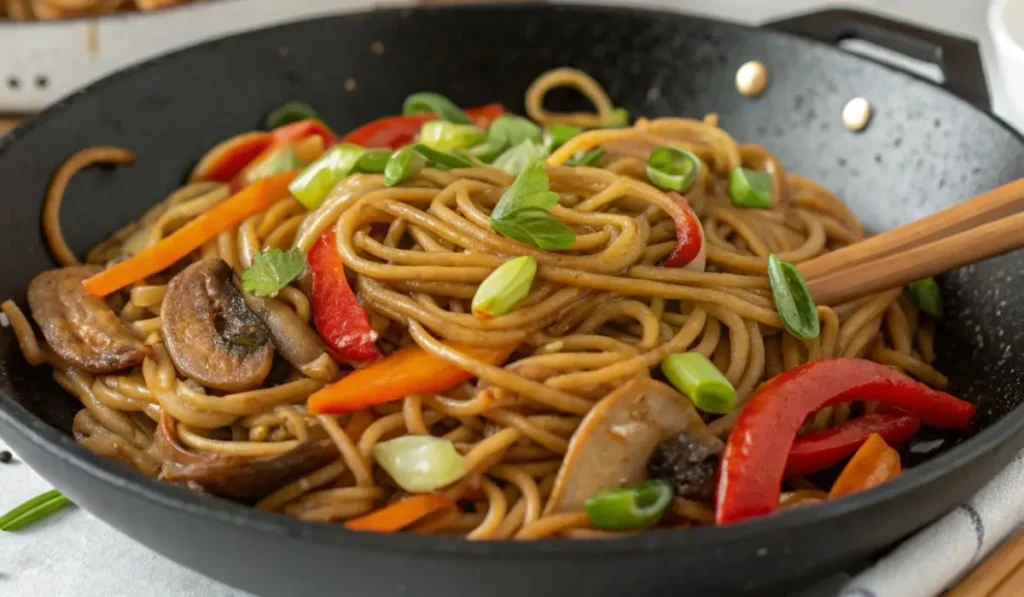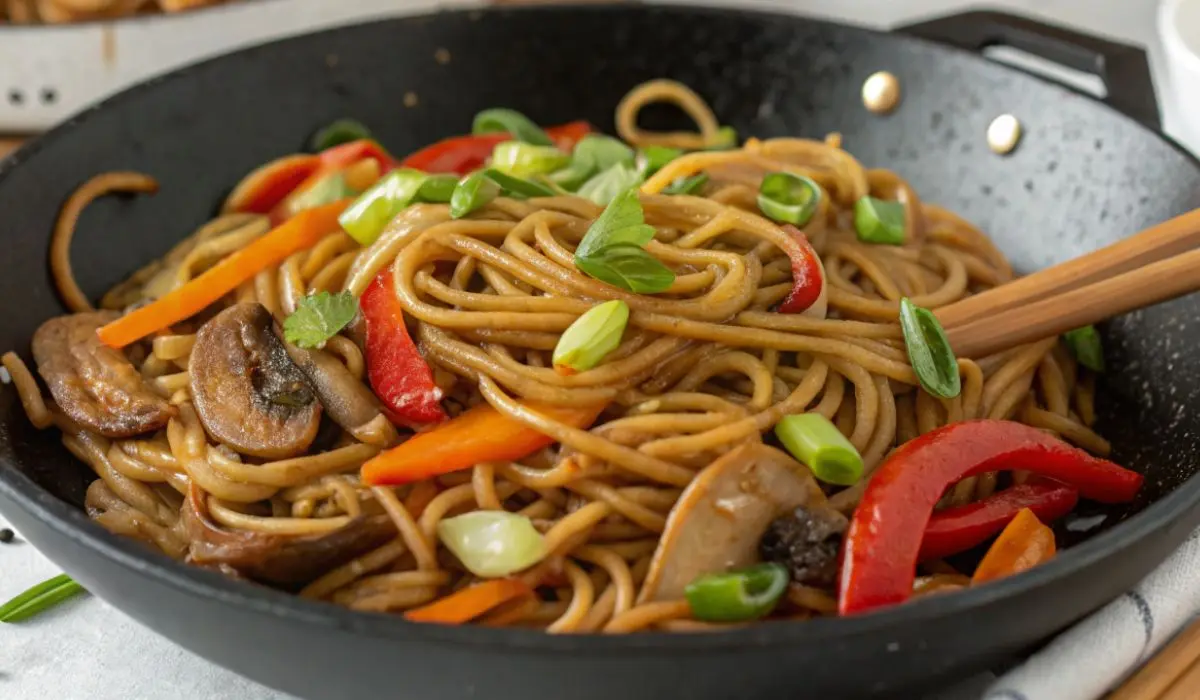This simple lo mein recipe transforms your kitchen into a takeout paradise in just 15 minutes. You’ll create restaurant-quality noodles using basic ingredients you likely already have at home.

Why This Lo Mein Recipe Works
Making homemade lo mein seems complicated, but it’s surprisingly simple. Most people think you need special ingredients or lengthy cooking processes. The truth is different.
This recipe uses everyday items like soy sauce, sesame oil, and regular noodles. The magic happens in how you combine them. A quality soy sauce creates the foundation for authentic flavor.
Essential Ingredients for Perfect Lo Mein
1. The Secret Sauce
Your lo mein sauce needs just five ingredients:
- 2 tablespoons dark soy sauce (regular soy sauce works too)
- 1 tablespoon light soy sauce
- 3 tablespoons oyster sauce
- 1 teaspoon sesame oil
- 1 teaspoon sugar
- 1 clove garlic, grated (optional)
Using two types of soy sauce creates deeper flavor. Dark soy sauce adds rich umami taste that elevates the entire dish. Light soy sauce provides the salty base.
2. Noodle Options
Fresh lo mein noodles work best when available. Most grocery stores don’t carry them, so these alternatives work perfectly:
- Dry ramen noodles (discard seasoning packets)
- Regular spaghetti noodles
- Rice noodles (for gluten-free option)
- Gluten-free spaghetti
3. Vegetable Choices
Pick 2-3 cups of your favorite vegetables:
- Mushrooms
- Carrots
- Bell peppers
- Bok choy
- Broccoli
- Cabbage
Step-by-Step Lo Mein Instructions
- Prepare Your Sauce. Mix all sauce ingredients in a jar. Shake well until combined. This creates your flavor base.
- Cook the Noodles. Prepare 4-6 ounces of noodles according to package directions. Drain and set aside. Don’t rinse them.
- Heat the Pan. Heat 1 tablespoon sesame oil in a large wok or skillet until very hot.
- Stir-Fry Vegetables. Add chopped green onions (white parts only) and vegetables. Stir-fry for 5 minutes until fork-tender.
- Add Mirin. Add 1-2 tablespoons mirin to deglaze the pan. This lifts the browned bits and adds sweetness.
- Combine Everything. Toss in cooked noodles with half the sauce. Mix everything together in the hot pan. Add more sauce until noodles reach medium brown color.
- Serve. Top with remaining green onions (green parts) and serve immediately.
Adding Protein to Your Lo Mein
Transform this vegetable lo mein into a complete meal by adding chicken, beef, or shrimp.
Slice your protein thinly. Coat with a small amount of lo mein sauce. Let it marinate briefly.
Cook the protein first in your hot pan. Remove and set aside while you prepare vegetables. Add protein back during the final tossing step.
Common Lo Mein Questions
What makes lo mein different from chow mein? Lo mein noodles are cooked and tossed. Chow mein noodles are fried until crispy.
Can I make this gluten-free? Yes. Use rice noodles or gluten-free spaghetti instead of wheat noodles.
Why use mirin? Mirin is rice wine that adds subtle sweetness. It balances the salty soy sauce perfectly.
How do I store leftovers? Refrigerate for up to 3 days. Reheat in a skillet with a splash of water.
Pro Tips for Better Lo Mein
- Use high-quality soy sauce. It makes a significant difference in flavor. Avoid takeout packets for this recipe.
- Keep your pan very hot. This creates the characteristic “wok hei” flavor that makes restaurant-style lo mein special.
- Don’t overcook vegetables. They should remain slightly crisp for better texture.
- Taste and adjust seasoning. Add more sauce if noodles look too light, or stop if they’re dark enough.
- Prep everything first. Have all ingredients ready before you start cooking for smooth execution.
Why Make Lo Mein at Home
- Cost-effective. Homemade lo mein costs less than takeout and tastes fresher.
- Complete control. You control the ingredients and can customize vegetables and proteins.
- Fridge cleaner. Use any vegetables that need eating. The flexible nature makes it perfect for meal planning.
- Speed. Making lo mein takes the same time as ordering delivery. You’ll have hot, fresh noodles in 15 minutes from start to finish.
- Healthier option. No preservatives or excess sodium like restaurant versions often contain.
Final Thoughts
This easy lo mein recipe proves that great Asian noodles don’t require complicated techniques or unusual ingredients. With basic pantry staples and fresh vegetables, you create satisfying meals any night of the week.
The combination of savory soy sauce, aromatic sesame oil, and perfectly cooked noodles delivers authentic flavors without the takeout price. Master this simple technique and you’ll never need to order lo mein again.
Start with this basic recipe, then experiment with different vegetables and proteins. Soon you’ll have your own signature lo mein that rivals any restaurant version.

15 Minute Lo Mein
Ingredients
Equipment
Method
- Make the sauce: Combine all sauce ingredients (dark soy sauce, light soy sauce, oyster sauce, sesame oil, sugar, and grated garlic if using) in a jar. Shake well until combined and set aside.
- Cook the noodles: Prepare the ramen noodles according to package directions. Drain thoroughly and set aside. Do not rinse.
- Heat the pan: Heat 1 tablespoon sesame oil in a large wok or skillet over high heat until very hot.
- Stir-fry vegetables: Add the white parts of green onions and your chosen vegetables to the hot pan. Stir-fry for about 5 minutes until vegetables are fork-tender but still slightly crisp.
- Add mirin: Pour in 1-2 tablespoons mirin to deglaze the pan, scraping up any browned bits from the bottom. This adds sweetness and depth.
- Combine noodles and sauce: Add the cooked noodles to the pan along with about half of the prepared sauce. Toss everything together in the hot pan to combine.
- Adjust seasoning: Add more sauce as needed until the noodles reach a medium brown color – not too light, not too dark. Taste and adjust seasoning.
- Serve: Remove from heat and serve immediately, topped with the remaining green onion (green parts) for fresh color and crunch.
